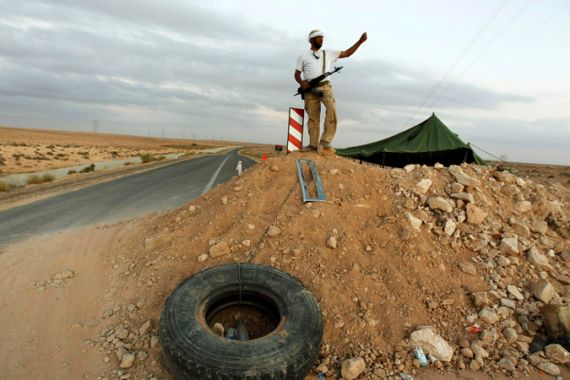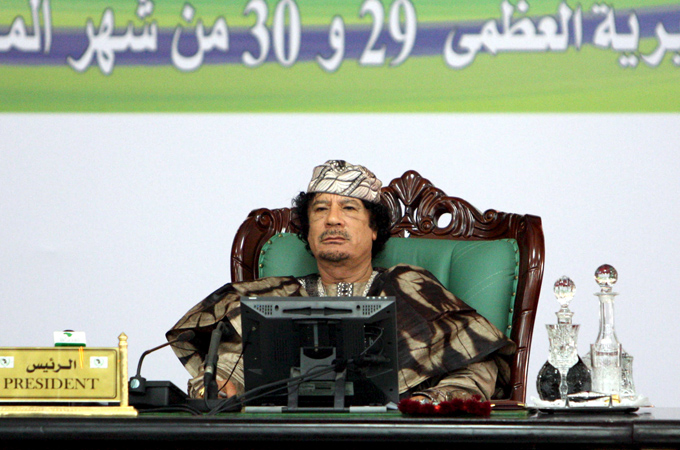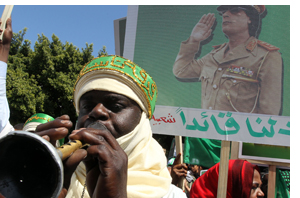Libya and the Sahel’s nightmare scenario
Libya’s uprising is causing turmoil in amid its neighbours and speculation of a Tuareg rebellion has emerged.

 |
| Around 500,000 migrants have returned to Niger, Mali and Chad since the Libyan uprising started in February [EPA] |
On September 5, the first of at least three convoys arrived in Niger from Libya, sending journalists scampering to this impoverished, desert state.
They reportedly carried members of the Tuareg who had allegedly been hired to fight for Gaddafi, 32 reported Gaddafi loyalists (including Mansour Dao – the widely loathed head of Gaddafi’s personal security retinue), two generals, Gaddafi’s son Saadi, and possibly substantial quantities of gold bullion and cash.
Prior to the start of Libya‘s revolution in February, the Sahelian regions of Niger and Mali had already suffered eight years of increasing political instability and insecurity. The reasons for this are complex:
First, having partially recovered from the Tuareg rebellions of the 1990s, the rulers of both Niger and Mali became willing, pliant and corrupt partners in the global war on terror (GWOT). This transformation occured following the complicity between the US and Algeria’s mukhabarat [security services] and the Departement du Renseignement et de la Securite [DRS – Department of Intelligence and Security] in fabricating terrorism in the region in order to justify the launch of the 2003 second front in the GWOT in the Sahel/Sahara. That alone brought an almost instant decimation of the predominantly Tuareg tourist industry and an annual loss of an estimated $50m.
Another factor contributing to instability in the region occured in 2005, following the political provocation of the Tuareg by the Niger government. This led to a short-lived rebellion, while in May 2006 the US and Algeria’s DRS orchestrated a Tuareg rebellion in northeastern Mali. This was followed, four to five months later, by two contrived “terrorist” engagements designed to facilitate the name change of Algeria’s GSPC into al-Qaeda in the Islamic Maghreb (AQIM) and its “insertion” into the Sahel.
‘Unsatisfactory peace process’
This duplicitous series of events led to more serious Tuareg rebellions in both Niger and Mali through 2007-2009, with an unsatisfactory peace process – brokered in large part by Gaddafi – which was accented by an upsurge in AQIM “terrorism“, drug trafficking and banditry.
|
“Tuareg justify [their actions] as an inevitable response to food shortages … marginalisation and the lack of both economic development and employment opportunities.“ |
Local Tuareg justify their marginal involvement in these activities as an inevitable response to food shortages (and in Niger, famine), their marginalisation and the lack of both economic development and employment opportunities.
The uprising that began in Libya in February against the Gaddafi regime quickly exacerbated the Sahel‘s wretched economic situation.
By May, it had already cost Niger billions in lost trade and the stemmed flow of remittences, causing President Issoufou to be forced to cut the 2011 budget by 6.55 per cent. Since then, the situation in Niger, Mali and Chad has deteriorated drastically – the governments of Mali and Niger each putting the number of returning migrants at more than 200,000 and Chad at more than 80,000.
For the first time in about 30 years, a large proportion of these countries‘ emigrant Tuareg population that had sought employment or refuge in Libya is coming home. Thousands of them had reportedly recently signed on as mercenaries; many more were long-serving members of Gaddafi‘s forces. However, not all of them fought for Gaddafi: Many supported Libya‘s National Transitional Council (NTC).
Either way, they are skilled fighters – armed and angry at what they see as a world that has once again turned against them. The final overthrow of the Gaddafi regime in August has turned this increasingly fragile and chaotic situation into what journalists in Niger are now calling a “powder-keg”.
Amongst these returnees are several former rebel leaders: Aghaly ag Alembo (Niger), Ibrahim ag Bahanga (Mali) who was killed (some say assassinated by “the Algerians”) on August 26, and assuming he is still alive, Mohamed ag Boula (Niger) – the brother of Rhissa ag Boula.
Rhissa was the leader of one of two main rebel movements in Niger in the 1990s and then the joint leader of the Armed Resistance Organisation (ORA) that signed the 1995 Ouagadougou Peace Accords. Since then, he has served as a government minister, been imprisoned on a trumped-up murder charge, headed another rebel movement (2008-2009) and is now an advisor to Niger‘s new president, Mohamed Issoufou.
 |
| The Tuareg complain of political and economic marginalisation [EPA] |
What are the plans of these and other Tuareg leaders? There has been speculative media talk of new Tuareg rebellions and even the possible emergence of some sort of militant, pan-regional Tuareg movement.
On top of all this, arms – including Sam 7s – are now widely reported to be flooding into the region from Libya. Indications are that they are being amassed by certain Tuareg (such as the late Bahanga), AQIM and drugs traffickers.
Whichever way one looks at this part of the Sahel, its immediate future is bleak. Indeed, the fact that the EU placed it at the top of its security agenda last year and is now pumping serious funds into the region is indicative of the seriousness of the situation.
The nightmare scenario
Amid the overwhelmingly pessimistic scenarios for this part of Africa’s Sahel region, the spill-over from Libya has given rise to one that the media has so far been reluctant to air. It is what I would call the “nightmare scenario”.
This starts with Gaddafi loyalists being not wholly dislodged from Libya. After the assumed eventual collapse of resistance in Sirte and Bani Walid, fort systems still remain – possibly around Sebha, the Traghan oases, the Wadi al-Ajal, Oubari, Ghat and perhaps elsewhere. Such areas of resistance then become supported – or, if lost – will be recaptured by an insurgency launched out of the Sahel. This resurgence will most likely come out of Niger, but with support from Mali, and perhaps from elsewhere where Gaddafi has spread his largesse.
Such an insurgency would depend on four key factors: The willingness of the Tuareg to take up the Gaddafi cause; the inability or unwillingness, for various reasons, of the governments of the region to prevent such developments; and insufficient financial resources and the inability or unwillingness of the West to intervene to stop it. A fifth factor, the “elephant in the room”, is Algeria.
One can only speculate on how the Tuareg might react to a further call to arms on Gaddafi’s behalf. Media interviews with Tuareg fighters who have just returned from Libya suggest that a significant number could still be mustered – especially if cash was on the table. Certainly, many Tuareg in Niger and Mali still feel they owe him a debt of gratitude, and therefore support.
Scattered leadership
However, behind the current, slightly gung-ho air of bravado, the political reality of the situation is still very unclear.
Aside from the fact that the Tuareg populations scattered across at least five countries of the Sahara-Sahel have never been politically unified, there are many schisms between them. And the same applies to many of their leaders, whose personal agendas are at present quite unclear, perhaps even to themselves.
National politics in all five countries (Niger, Mali, Burkina Faso, Algeria and Libya) are also very different, although Tuareg in all of them share a sense of political and economic marginalisation. In addition, there is much common anger and disillusionment – especially against the US, France, the EU, and the West as a whole for failing to help them in their recent predicaments.
|
“There is much common anger and disallusionment among [the Tuareg] … that, in itself, may be sufficient to maintain some sense of loyalty and gratitute to Gaddafi, the only person who has come to their aid.“ |
That, in itself, may be sufficient to maintain some sense of loyalty and gratitude to Gaddafi, the only person who has come to their aid – albeit for reasons of self-interest – since the launch of Washington’s GWOT sent the region into a spiral of increasing insecurity and instability.
Another factor in the “Tuareg equation”, which should not be discounted, is Gaddafi’s proposition to make a Tuareg political entity of “state” that would somehow be carved out of the Sahara and Sahel. This proposition was first mooted in a speech at Oubari in 2005 and written off as “crazy” by all except Algeria.
Parallels have been drawn to France’s attempt in 1957 to carve its own “Saharan state”, the Organisation Commune des Régions Sahariennes (OCRS), out of its colonial territories in defiance of Algeria’s fight for independence.
The likelihood of the Tuareg taking up arms again Gaddafi’s behalf, or as part of a “post-Gaddafi” movement, is unlikely. Nevertheless, if Niger and Mali, with the financial assistance of international development aid, are unable to provide an alternative and more attractive future, it cannot be ruled out.
Whether Niger or any other Sahelian country would accept such a “rear base” in its territory is also most unlikely. The mere presence of Gaddafi, his family or key loyalists in any of these countries will be a disruptive and potentially destabilising force.
However, the popular support for Gaddafi in these Sahelian countries, and not only from the Tuareg, will make it very difficult for any of their governments to fulfil their international obligations. Although a Niger government spokesman has made it clear that Gaddafi’s supporters would not be sent back to Libya, he did say that, if any of these people were wanted by an international court with universal competence over the crimes for which they were being pursued, Niger would do its duty in terms of its commitments to international justice.
Those may be the sentiments that the government would like to pursue and what the international community would like to hear, but these governments are weak and internal political pressures may well come to stand in their way.
The most important factor, of course, is whether the Gaddafists could finance such an insurgency.
This would depend on three factors: How much bullion and cash, if any, was brought into the Sahel in the convoys of the last couple of weeks; what other assets Gaddafi may still have stashed away in other parts of the world that could be drawn on and, perhaps most pertinent of all, whether the conditions of the vast “loans” given to these Sahelian countries, notably Mali and Niger, might provide him, his family or followers with income.
As for the willingness or ability of the West to intervene, that too is something of an open question. Would the West really welcome what would inevitably be a show trial if Gaddafi and/or his indicted sons and followers were brought to The Hague?
And would such an insurgency, if contained to the Sahara-Sahel, really be contrary to western interests? It would certainly give a fillip to AFRICOM’s raison d‘être and provide British, France and perhaps other European intelligence services with a new lease on life.
 |
| The most important factor in a renewed Gaddafi insurgency is funding [EPA] |
Algeria: The elephant in the room
A fifth and key factor in this scenario is Algeria. Notwithstanding its denials, the Algerian regime (not the Algerian people) provided substantial support to the Gaddafi regime from the outset of the rebellion.
This support is continuing, with the provision of sanctuary to members of Gaddafi’s family on humanitarian grounds, in spite of the fact that there is so far no proof (other than Algeria’s word for it) that Aisha Gaddafi did give birth, and continuous attempts to destabilise the NTC. Algeria’s regime fears that a successful rebellion against Gaddafi’s dictatorship and the emergence of a “democratic Libya” would threaten its own hold on power.
|
“Algeria’s regime fears that a successful rebellion against Gaddafi’s dictatorship and the emergence of a ‘democratic Libya’ would threaten its own hold on power.“ |
Whether Algeria would support such an insurgency is debatable. Key members of Algeria’s broad oppoisition with whom I have discussed this matter believed that it is possible, but not necessarily through the provision of manpower and arms (which the insurgents are likely to have in abundance). Their support would come in the form of tacitly opening key borders and thus allowing passage between the Fezzan and Niger – as is believed to have occured with at least one of the convoys that fled from Libya to Niger earlier this month.
Access to fuel supplies would also not go amiss. Moreover, these two remote and adjoining corners of Algeria and Libya are served by the airports of Djanet and Ghat respectively, both being far from prying civilian eyes.
Indeed, local labourers in Ghat once told me that Gaddafi built substantial bunker facilities underneath Ghat airport. Whether he envisaged them being used for such an insurgency, or perhaps even for his own flight, are open questions.
Most of the extreme southeast of Algeria is effectively a closed military zone. It is therefore almost impossible to know what is happening there. Some local nomads have claimed that the DRS is provisioning AQIM camps just across the Algerian border into Niger, such as the I-n-Tadéra camp that was attacked this month by Niger’s army.
Moreover, such covert support for any such insurgency would fit well into Algeria’s own hegemonic designs on the Sahel, for which it has been heavily responsible for destabilising.
In 2009, a Malian intelligence officer, Col Lamana Ould Cheikh, said, just before his assassination, that the DRS was at the heart of AQIM; while last year a senior Mauritanian Minister accused Algeria of being the porte-parole for AQIM.
The US, UK and France are aware of these antics. However, having stood by and supported the Algerian regime and it DRS for so long, they are now beginning to lose patience.
President Bouteflika’s reforms are going nowhere, except in exacerbating the anger of the bulk of the country’s citizens. Interior Minister Ould Kablia’s recent ridiculous remarks about “Zionist” and other “foreign parties” trying to incite the Algerian people to rebel irritated the US and merely confirmed Ould Kablia (like many others in the regime) as an out-of-date ideologue of the 1960s. And the DRS’ use of its “beltajas“ [thugs] to attack the El Watan newspaper printing works on September 14 was noted with concern by western diplomats in Algiers.
Algerian support for such an insurgency, even by simply opening its borders and allowing passage between Libya and Niger, could be “the last straw”.
|
“Algerian support for such an insurgency … could be ‘the last straw’. “ |
With the West now seemingly likely to gain more secured access to Libyan oil, we are likely, in any case, to see a substantial shift in western interests and support from Algeria to Libya. Indeed, as Sergei Balmasov opined this week in Russia’s Pravda: “The West does not need to take much effort to launch the revolution in Algeria. [It] only needs to give the country a push in the right direction.”
If the West were to cast the Algerian regime adrift, as this scenario would deem likely, it would not be able to resist its own “Arab Spring” for long. And, if it did, it would quickly revert to the international pariah status that it achieved in the 1990s.
Jeremy Keenan is a professor of social anthropology at the School of Oriental and African Studies in London and is the author of The Dark Sahara: America’s War on Terror in Africa, Pluto Press, 2009.
The views expressed in this article are the author’s own and do not necessarily represent Al Jazeera’s editorial policy.
